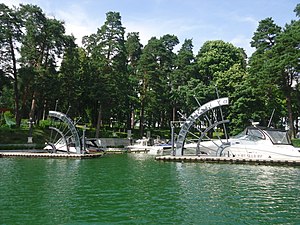Pojezierze Litewskie
| Pojezierze Litewskie | ||
|---|---|---|
|
Lake Wigry |
||
| Highest peak | Rowelska Góra ( 299 m ) | |
| location | Warmia-Masuria , Podlasie , Poland | |
|
|
||
| Coordinates | 54 ° 16 ′ N , 22 ° 49 ′ E | |






The Pojezierze Litewskie ( "Lithuanian Lake District"), in the western part as Pojezierze Suwalskie ( " Suwałki Lake District called"), a macro-region as well as lakes landscape in the provinces Warmia-Mazury and Podlasie in Poland .
etymology
The name goes back to the neighboring state of Lithuania or the city of Suwałki . The Lithuanian Lake District continues to the east in Lithuania, but is not so named there. In Lithuania it is called the Vilnius Lake District (Lithuanian: Aukštaičių aukštuma ).
location
The Lithuanian Lake District is part of the East Baltic Lake District , which in turn is part of the East Baltic-Belarusian Plain . The Masurian Lake District joins in the west and the Podlachian-Belarusian mountain ranges in the south . The lake district is located in the far northeast of Poland on the border with Russia , Lithuania and Belarus . The climate here is more continental than in any other Polish region. Here - the mountain ranges of the Sudetes and Carpathians are not included - the lowest temperatures in Poland were measured.
structure
The macroregion of the Lithuanian Lake District is divided into four mesoregions :
geology
The Lithuanian Lake District consists of a large number of lakes in a moraine landscape. Characteristic of this landscape are glacial channels between the hills, created by the erosive effect of the meltwater when the glaciers melted , which later took up the lakes. The lake district has a size of about 3500 km². The Kashubian , the Pomeranian , the Masurian Lake District and the Greater Poland Lake District are similar in terms of development history and landscape .
Lakes
The largest lake is the Wigry (21.7 km²). The deepest lake in Poland is Hańcza, which is 113 meters high . Other important lakes in the region are Serwy , Szelment Wielki , Jezioro Boczne , Rospuda Filipowska and Gaładuś . There are a total of around 250 lakes, each of which is larger than one hectare.
Rivers
The Lithuanian Lake District drains mainly to the northeast via the Memel into the Baltic Sea . The most important rivers are the Netta , Czarna Hańcza and Rospuda . It is one of the most popular kayaking routes in Poland, flowing over 100 km through dozens of lakes.
channels
Many of the lakes are connected by canals such as the Augustów Canal , which connects the Biebrza in the Vistula river system with the Memel . You can navigate large parts of the lake district up to the Baltic Sea via the canal .
Moraines
The highest moraine in the area is the Rowelska Góra with 299 meters above sea level.
colonization
The Lithuanian Lake District is sparsely populated. There is not a single big city. The important small towns in the region are:
nature
flora
Parts of the Lithuanian Lake District are covered with dense primeval forests, especially in the south by the Augustów Heath . From the 15th century, the forests were partly cleared to use the moraines for agriculture. The vegetation differs significantly from the Masurian Lake District. Due to the colder climate, the flora here is much more northern with strong (sub) boreal and (sub) arctic influences.
fauna
The Lithuanian Lake District has a similarly rich fauna as the Masurian Lake District. There are numerous large mammals such as meadow moose, elk, deer, roe deer, wild boar, beaver, wolf, lynx, fox, marten and badger. The bird world is rich in species. There are golden eagles, hawks, buzzards, falcons, herons, cranes and cormorants. Common amphibians and reptiles are turtles, newts, lizards and various types of snakes. Catfish, pike, perch, eel, carp, trout and many other species can be found in the lakes. Insects include butterflies, bees, dragonflies, and many others.
natural reserve
National park
The Wigierski National Park occupies around 15,086 hectares and is located on Lake Wigry .
Nature reserves
There are numerous nature reserves in the region.
economy
In the absence of industry, the region in Poland is considered to be economically weak. The economy is primarily focused on forestry, timber industry and services, especially tourism.
tourism
The Lithuanian Lake District is an important tourist destination with a large number of marinas, swimming areas, fishing opportunities, moorings, well-developed long-distance hiking and long-distance cycling routes, campsites , hotels and restaurants . However, it stands in the shadow of the Masurian Lake District , which was developed earlier and better for tourism. In contrast to this, the Lithuanian Lake District is still considered the wild north-east of Poland.
The most famous kayak routes lead along the rivers and canals:
literature
- Andrzej Ber: Pojezierze Suwalsko-Augustowskie. Przewodnik Geologiczny. Warszawa: Wydawnictwa Geologiczne, 1981. ISBN 83-220-0131-2 .


